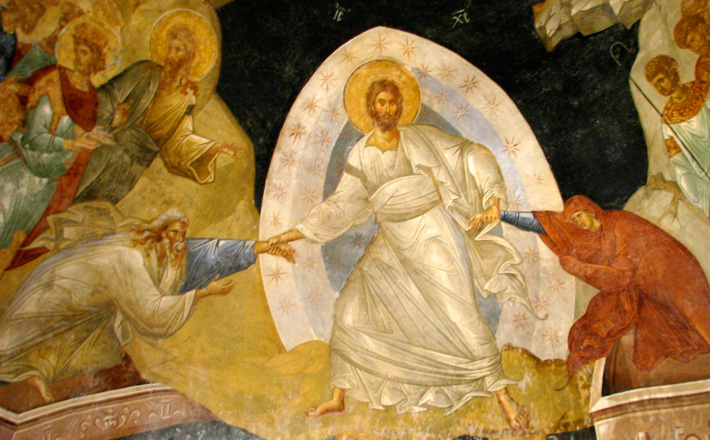Commentary on Job 19:23-27a
“I know that my Redeemer lives!” Perhaps you, like me, can’t help but hear music when you read those words. The great Easter hymn by Samuel Medley begins and ends with this proclamation:
I know that my Redeemer lives!
What comfort this sweet sentence gives!
He lives, he lives, who once was dead;
he lives, my ever-living head!
And, of course, Handel wrote a glorious soprano solo on these words. You can find one rendition here. It is the piece in “Messiah” that follows the “Hallelujah” chorus, carrying forward the joy of that chorus and expanding on the reason for the joy. The music soars, proclaiming hope in the face of everything that would deny it: “I know that my Redeemer liveth, and that he shall stand at the latter day upon the earth. And though worms destroy this body, yet in my flesh shall I see God.” Then Handel follows this cry from Job with a proclamation from 1 Corinthians 15:20: “For now is Christ risen from the dead, the first fruits of them that sleep.”
“I know that my Redeemer lives!” cries Job out of the depths of despair. And Christians through the centuries, including Medley and Handel, have heard that cry as a witness to the resurrection of Jesus and thereby to their own resurrections.
Historically speaking, of course, the author of Job was probably not espousing belief in resurrection with this proclamation. In fact, just a few chapters earlier, Job explicitly refutes any idea of life after death.
For there is hope for a tree,
if it is cut down, that it will sprout again,
and that its shoots will not cease …
But mortals die, and are laid low;
humans expire, and where are they?
As waters fail from a lake,
and a river wastes away and dries up,
so mortals lie down and do not rise again;
until the heavens are no more, they will not awake
or be roused out of their sleep. (Job 14:7, 10-12)
Judging from many Old Testament texts, including this one, belief in resurrection was not a part of the world of ancient Israel. It was a later doctrine, developed in the centuries after the exile. Indeed, as our Gospel lesson for today shows, it was still a controversial claim in Jesus’ day. The Pharisees believed in the resurrection of the dead; the Sadducees did not.
What, then, is this statement doing in the midst of the book of Job? “I know that my Redeemer lives.” It is a striking affirmation, particularly given what comes before it. Job, bereft of children and wealth, accused by his so-called “friends” and covered with boils, falls into the depths of despair, wishing first for death (Job 3) and then for justice (Job 9). His family and his close friends have failed him (Job 19:14). Worst of all, the God whom he has known and served his whole life has now turned against him.
“He breaks me down on every side, and I am gone, he has uprooted my hope like a tree. He has kindled his wrath against me, and counts me as his adversary” (Job 19:10-11).
Where is Job to turn? Abandoned by friends and family, he turns to the only source of help left – he turns to the God whom he has just accused of destroying him: “I know that my Redeemer lives, and that at the last he will stand upon the earth; and after my skin has been thus destroyed, then in my flesh I shall see God, whom I shall see on my side, and my eyes shall behold, and not another.”
Clinging to the God whom he also at the same time accuses — this is the paradoxical stance of faith that Job takes. It is the posture of lament — holding on to God with one hand and shaking your fist at God with the other; not letting God off the hook for one minute, but staying in relationship with that God. Job exemplifies that posture of lament, and it is precisely that refusal to give up on God that leads to moments of inexplicable hope in the midst of his overwhelming despair, hope that God will “remember” Job and “long for” him (Job 14:13-15); hope that his Redeemer lives and that in the end, Job himself will see God (Job 19:25-26).
Time does not permit the recounting of how Job finally does see God.1 Suffice it to say that at the end of the book, after God shows up and takes Job on a whirlwind tour of creation, Job says this, “I had heard of you by the hearing of the ear, but now my eye sees you” (Job 42:5). Job’s hope has been fulfilled, not perhaps in the way that he expected, but fulfilled nonetheless. And it is the fulfillment of that hope that leads Job to embrace life again.
At the end of the book, Job and his wife have more children. After the cataclysm, Job makes the choice to live again, bringing more children into a world that is both heartbreaking and heartbreakingly beautiful. Though the book of Job does not espouse an explicit belief in resurrection, then, it does participate in that biblical movement that eventually leads to the doctrine of the resurrection of the dead. According to the biblical witness, God leads God’s people, again and again, from slavery to freedom, from exile to homecoming, and from death to life.
Job’s story of new life after inexplicable suffering contributes to that trajectory in the Old Testament that culminates in the doctrine of the resurrection of the dead. Jon Levenson writes of the restoration of Job as described by his friends; though not resurrection of the dead,
It is a reversal nonetheless, the replacement of despair with hope, of gloom with shining light. It was such a reversal in the same direction, a restoration in the same direction, that the rabbis (along with their Pharisaic antecedents and Christian contemporaries) expected in the future resurrection of the dead.2
Job’s movement from despair to hope, from death to life, is made explicit in the Septuagint translation of the book. The translators added this note to the end of the book: “And Job died, old and full of days. And it is written that he will rise again with those whom the Lord raises up.”
“I know that my Redeemer lives!” Job clings even in the midst of despair and grief to the God whom he also accuses. And in the end, against all odds, his hope is fulfilled. He sees God; and having seen God, he is drawn back into life again.
“I know that my Redeemer lives!” For millennia, through prayer and preaching and beautiful music, the Church has proclaimed that Redeemer to be Jesus the Christ. It is a word of hope in the face of despair, a word of life in the face of death. And so it is a word appropriate to this All Saints’ Sunday, when we remember and celebrate the saints who have gone before us, the saints (including Job) who clung in faith, against all odds, to the God of Abraham, Isaac, and Jacob, the God of the living (Luke 20:38), who is faithful even until death, and beyond.
Notes:
1 For a deeper discussion of the God speeches and the last chapter of the book of Job, see my commentary here.
2 Jon D. Levenson, Resurrection and the Restoration of Israel (Yale, 2006), p. 70.


November 6, 2016